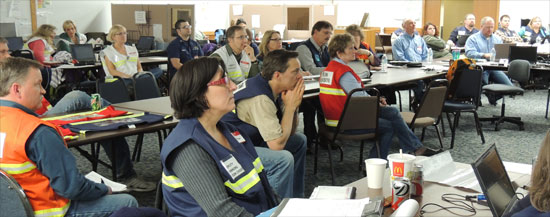A contingency plan is a course of action designed to help us effectively respond to a significant future event or situation that may or may not happen. Representing the public’s interest, Cook Inlet RCAC evaluates the adequacy of the Unified, Subarea, and Industry Oil Discharge Prevention and Contingency Plans (ODPCP or C-Plan). The State of Alaska requires C-plans to be reviewed on a five year review cycle; however, when an amendment to the plan substantially affects the operator’s ability to respond, the state requires a plan review. Both instances incorporate a public review period.
By state regulation, Cook Inlet RCAC is a named C-Plan reviewer. Along with regulatory agencies, plan holders are required to provide the RCAC with a copy of their C-plan for review. Throughout the review, staff works with state agencies and industry, thus reinforcing their role in protecting Cook Inlet’s productive waters. A thorough review of these plans is especially important to identify areas that do not appear to meet regulatory intent or compliance. Working within the review process, the Protocol Committee develops requests for additional information to clarify ambiguous statements or procedures and provides recommendations for improvements.

Oil spill drills have not always been the active prevention and response tool in Cook Inlet that they are today. In the years following the Exxon Valdez oil spill, regulators clarified expectations and the response organizations developed their own internal protocols.
The first spill drill was to be with Tesoro in Anchorage to demonstrate a laden tanker’s ability to drop anchor and use it as a breaking system to slow and eventually stop its movement. As pressure to hold the drill diminished, discussions turned toward the drill scenario itself.
In September of 1991, the U.S. Coast Guard called a drill on Arco. The scenario was an earthquake, which ruptured a line between a platform and the Trading Bay facility releasing 100-200 barrels of oil into the inlet. Cook Inlet RCAC observers at the drill deemed the booming and mechanical clean up effective from their perspective and participated in a workgroup tasked with compiling all information from spill drills and reporting back to the PROPS (Prevention, Response, Operations and Safety) committee. The next month, Marathon Oil conducted a drill exercise in Anchorage and again Cook Inlet RCAC observers attended and later compiled information for the PROPS Committee.
In 1992, Alyeska and Chevron conducted a joint operation in Prince William Sound. At this drill, Cook Inlet RCAC observers were impressed with the interaction between Prince William Sound RCAC and the Unified Command. Both Cook Inlet RCAC and Prince William Sound RCAC spent the next few drills figuring out the role that they would play in training exercises. Observers continued to note opportunities for improvement in aspects such as boom deployment and communication between response vessels. Cook Inlet Spill Prevention and Response, Inc. (CISPRI) incorporated some of Cook Inlet RCAC’s suggestions regarding the Incident Command System (ICS).
Today, drills fulfill three functions; first to verify or test an operator’s response readiness and effectiveness; second to exercise all areas of the contingency plan to ground truth its effectiveness; and third to improve the operator’s ability to respond to a real incident by allowing the incident management team to practice the plan’s procedures and implement lessons learned. Cook Inlet RCAC works with industry and agencies to assure that areas in need of improvement are identified and lessons learned are implemented. Cook Inlet RCAC staff often participates in drill planning, working with industry and agency representatives to develop a drill’s scope and parameters. Cook Inlet RCAC participates in industry and agency led drills by imbedding into the Incident Command System (ICS) to provide advice and make recommendations to the Unified Command and individual incident command sections. Through this cooperative effort, industry and agencies are able to identify areas in need of improvement and implement changes to make the contingency plan a more effective prevention and response tool.
Cook Inlet RCAC’s role continues to evolve but remains aimed at improving the ICS and the interaction with various stakeholder groups and affected citizens.
Review, evaluate, and comment on the adequacy of the unified, sub-area and industry contingency plans.
Review, evaluate, and comment on legislative and regulatory development.
Include non-tank vessel and refined product facility operations as routine part of contingency plan review.
5002 (f)(2)
(A) periodically review the respective oil spill prevention and contingency plans for the terminal facilities and for the crude oil tankers while in Prince William Sound or Cook Inlet, in light of new technological developments and changed circumstance;
(E) monitor periodic drills and testing of oil spill contingency plans for the terminal facilities and crude oil tankers while in Cook Inlet.











